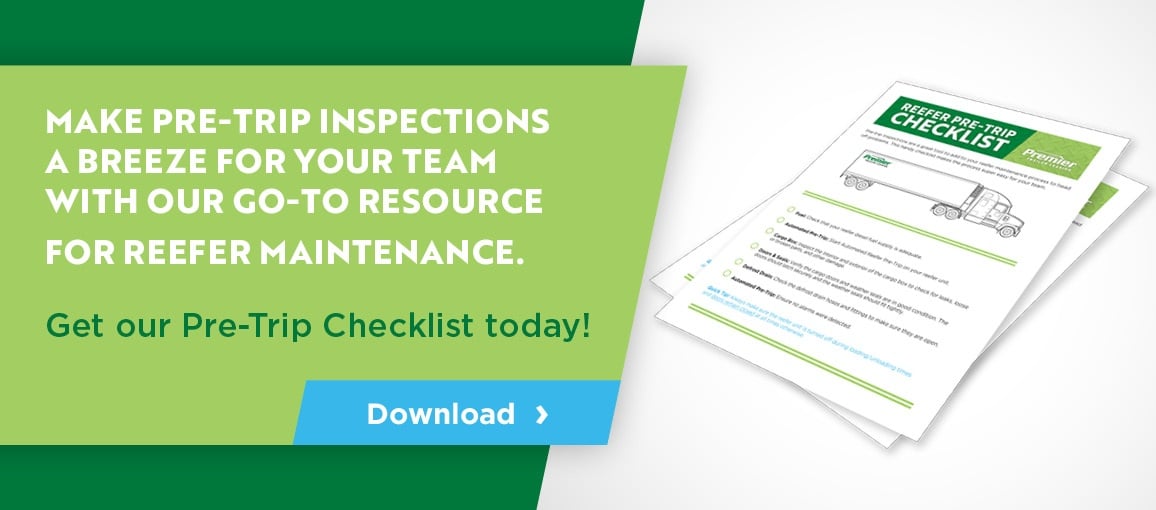By Miles van Rijn, Regional Operations Manager
Curious what a reefer trailer is or what it can do for your business? Watch the walkthrough video or follow the text below for a reefer trailer walkthrough covering the important features, components, and parts of reefer trailers.
What Are Reefer Trailers?
In a nutshell, a reefer, short for “refrigerated trailer,” is a regular semi-trailer with an engine on the front and a fuel tank underneath that allows you to keep products at a certain temperature.
Because of its cooling ability, reefer trailers do require a bit of extra maintenance compared to other types of trailers. So it’s important you and your team understand the major parts and components of a reefer trailer before you start operating one.
Functional Components of a Reefer Trailer
Reefer Engine
Let’s start at the front of the trailer. Here you will find the reefer engine. In our video example, we show you a Thermo King C-600.
Did you know?: Not all reefers are used for cooling. Some reefers hold products at a relatively warm temperature instead. Pharmaceutical companies, for example, have products that need to be housed at 72 ℉.
Control Panel
The control panel is where you manually control the reefer unit. It also stores and collects data and allows you to conduct an automated pre-trip inspection. On units with an alarm system, the control panel will display malfunction alerts. It feeds alert signals to the driver indicator light, which indicate in red or amber that there is a problem. The indicator light is visible in the driver’s rear-view mirror. Through the tracking system, alarm notifications are also emailed, so your team can take the right actions to save a load if a malfunction occurs.
From the control panel, you can select from two temperature control modes for your reefer trailer:
- Cycle Sentry Mode: If you run your reefer in Cycle Sentry Mode, it works much like your thermostat at home. You can set the temperature, and when it varies by just a few degrees, the cooling mechanism will activate to maintain your intended temperature. The advantage of this mode is that it’s fuel efficient.
- Continuous Mode: With Continuous Mode, your thermostat will never stop running. It will always be heating or cooling to hit the exact right temperature. That makes it perfect for sensitive products. However, Continuous Mode is not fuel efficient.
Battery
You’ll find the battery behind the white paneling surrounding your control panel. It will either be a wet cell or an ion battery, an option that we at Premier switched to in 2021.
Working Components
You can find the main working components, such as the engine and compressor, in the panel to the left of the control panel.
Fuel Tank
The fuel tank holds around 50 gallons at a time. If your fuel falls to 7.5 gallons, it will trigger an alert. When you receive this alert, it should give you or your team around two hours to refill your tank.
Rear Components of a Refrigerated Trailer
Rear Door
Reefers generally come with either a swing or a roll door. Reefer swing doors are much thicker than a van’s swing doors because they’re insulated. This insulation is designed to maintain a consistent temperature in the trailer. You also have the option to choose a trailer with a roll door.
Inside a Reefer Trailer
Interior Floor
The floor of your reefer trailer rental may be what we call a duct floor or a flat floor. Duct floors are grooved, allowing air to flow through more evenly. Flat floors are generally designed to hold palletized material.
Airflow Chute
The airflow chute is on the ceiling of the trailer’s interior. The chute carries air from the engine and distributes it out of its sides and its back. This prevents hot spots and protects your load by spreading air out evenly. At the rear of the airflow chute is a mesh that serves as an anti-snag feature, protecting your chute from being ripped off when you’re loading your trailer.
Note: When the reefer is in use, the airflow chute will inflate. When it isn’t in use, it will deflate in order to stay out of the way!
Interior Walls
The interior wall of a reefer is highly damage-resistant. It’s built to protect against loading damage. If the interior wall is damaged, moisture could leak into the foam, making the reefer less efficient.
Bulkhead
The bulkhead, located on the far cab-end wall of the reefer, draws air into the reefer from the lower section of the trailer.
Pallet Stops
Below the bulkhead, there are black, rounded pallet stops. These pallet stops act as a protective buffer to protect the reefer unit from being damaged during loading.
Find the Perfect Trailer for Your Company
Hopefully, this walkthrough showed you everything you need to know about the major components of reefer trailers. If you want to learn more about trailers or are looking for a great resource for your teams, download our Trailers 101 Guide or sign up to receive the next walkthrough video and other helpful tools and articles on semi-trailers right in your inbox!
 Miles van Rijn is a Regional Operations Manager for Premier Trailer Leasing. With 15 years of trailer operations experience, he has seen it all and enjoys sharing his expertise with Premier's branch leaders as well as customers. Miles is always happy to help. Connect with him on LinkedIn!
Miles van Rijn is a Regional Operations Manager for Premier Trailer Leasing. With 15 years of trailer operations experience, he has seen it all and enjoys sharing his expertise with Premier's branch leaders as well as customers. Miles is always happy to help. Connect with him on LinkedIn!







